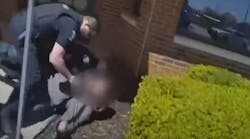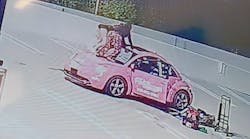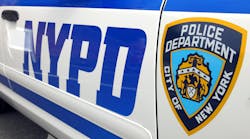By Lyndsay Winkley
Source The San Diego Union-Tribune
San Diego police officials said more than 100 smart streetlights have been turned on since the surveillance network got final approval late last year, and the technology is already making a difference in cases.
The department first proposed the controversial network — made up of 500 cameras, all of them equipped with automated license plate reader technology — in March. Once installed, San Diego would become the largest in the country to use cameras and plate readers as part of a single network, San Diego police officials have said.
The cameras, which police have hailed as a force multiplier and a crime-fighting tool, would be located across San Diego, with the highest concentrations in District 8, which includes communities such as Barrio Logan, Logan Heights, Otay Mesa, and District 3, which encompasses Hillcrest, North Park and downtown San Diego.
A map on the city's website shows where cameras have been turned on so far, with many clustered around freeways and main thoroughfares. Nearly every council district has a few cameras up and running. The map will be updated weekly, police officials said.
"Instead of casting a large net based on sometimes vague descriptions, the Smart Streetlights cameras and (license plate reader) system now allow us to be laser focused and apprehend suspects event faster," Police Chief David Nisleit said in a statement. "This investment is precision, intelligence-led policing at its finest and will deliver results."
And they've already helped crack cases, the department said Friday. Police officials said the network has been used to investigate more than 20 cases, including burglaries, robberies, stolen vehicles and four homicides.
Last month, a victim was robbed at gunpoint in the Nestor community after being pulled over by what they thought was a law enforcement vehicle flashing its red-and-blue lights. Investigators had very little information, but were able to use the camera and license plate reader system to find their suspect, who they arrested on suspicion of robbery, conspiracy and impersonating a police officer.
In another case, an officer used the system to track down a stolen car near the UTC mall. The officer notified the department's Northern Division, and officers found the stolen vehicle in one of the mall's parking structures. They also located the suspect, who was in possession of the stolen vehicle's keys and the key to another stolen vehicle. He was arrested on suspicion of auto theft, possession of a stolen vehicle and two misdemeanor warrants.
Officials declined to release more information about the homicide cases, citing ongoing investigations.
"Having our Smart Streetlight and (license plate reader) technology is already making our city safer, with examples just in the first two months of operating that show their ability to help police locate and apprehend dangerous suspects more efficiently and with greater certainty," Mayor Todd Gloria said in a statement.
The network, which will cost the city nearly $12 million over the next five years, prompted fierce pushback from community members before the City Council gave its seal of approval. Critics contended the cameras would be invasive, the policies governing the technology's use don't do enough to safeguard privacy, and funding for the project would be better spent on other public safety initiatives.
San Diego will spend about $3.5 million in fiscal 2024 on hardware, software, connectivity, installation and maintenance and $100,000 to replace the LED lights. The network will cost about $2 million annually over the remaining four fiscal years.
Privacy advocates have also argued that most of the data collected by automated license plate readers — information that has the potential to reveal where people shop, worship or protest — doesn't assist in crime fighting. In the last 30 days, San Diego's system has scanned nearly 1.2 million unique license plates, police officials said.
About a tenth of 1 percent of those scans — 1,457 — activated a crime alert.
Department officials have stressed safeguards are in place to ensure the technology is used in a way that protects people's rights and privacy. The cameras will be in public places where there is no expectation of privacy, and before one is turned on, the department's special projects and legislative affairs unit individually reviews the camera's viewpoint to digitally mask private property.
The cameras are not monitored in real time; instead, investigators will access the network after serious crimes or incidents occur, police have said. Videos captured by the streetlights are deleted after 13 days and license plate data is deleted after 30 days, unless the information is being used in an active investigation.
Officers and investigators must be trained before they can log into the system — so far 1,030 have done so — and a case number is created whenever someone accesses it so the agency can monitor how the technology is being used.
Per policy, the department does not share data with other law enforcement agencies, in part because it would be difficult to ensure other departments adhere to the same privacy guidelines San Diego set up for its data, such as how long data can be retained.
The network is expected to be fully operational by June. Department officials noted that the system can only operate in conjunction with an LED streetlight. If an LED streetlight is already in place, the technology can be easily integrated. If a light isn't LED-equipped, the department works with the city's transportation department to install one.
This is the second time in recent years that City Council members have approved a network of smart streetlights.
In 2016, council members signed off on a $30 million project that pledged to use energy-saving smart streetlights to assess traffic and parking patterns throughout the city. What the public didn't know — and wouldn't know for years — was that the technology came with cameras that could be accessed by police.
The resulting outcry — based on concerns about privacy and equity — led San Diego to shut down the network and fueled the creation of a surveillance ordinance that governs the use of smart streetlights and similar technologies.
Before losing access to the technology, police had used footage from the smart streetlights to investigate hundreds of cases, including 56 homicides or attempted homicides, 55 robberies or burglaries and 55 assaults involving a weapon.
Last month, a state appellate court upheld a murder conviction in a 2019 case solved by using information gleaned from streetlight cameras, finding that the defendant did not have an expectation of privacy as he moved about on a downtown San Diego street. That case was among the first times that San Diego police investigators had accessed the streetlight camera footage.
Staff writer Teri Figueroa contributed to this report.
_____________
©2024 The San Diego Union-Tribune.
Visit sandiegouniontribune.com.
Distributed by Tribune Content Agency, LLC.


